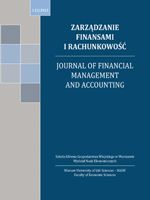Main Article Content
Article Details
BONNISSEAU J.M., ACHIS CH. 2014: On the equivalence of financial structures with long-term assets, Documents de travail du Centre d'Economie de la Sorbonne, Retrieved from http://hal.archives-ouvertes.fr/hal-01130785/document.
CHIZHEVSKA L.V., VYHIVSKA I.M., DYKYJ A.P., SKAKUN L.S. 2011: Accountant Professional activities: outsourcing, risk, information security, Ruta Ent., Zhytomyr.
COTTER D. 2012: Advanced financial reporting: A complete guide to IFRS, Financial Times/Prentice Hall.
EMAMI M., ALI M., NABIOLLAH M. 2015: Survey on the Relation between Firm Size, Net Working Capital and Long-Term Operating Assets with the Return on Assets in the Companies Approved in Tehran Stock Exchange, European Online Journal of Natural and Social Sciences 4.1, 706.
GERVASIO D., DAMIANO M. 2013: IFRS Subjectivity: the other side of the coin, Universal Journal of Accounting and Finance 1.2, 58-69. (Crossref)
GINER B. 2014: Accounting for Emission Trading Schemes: A Still Open Debate, Social and Environmental Accountability Journal 34.1, 45-51. (Crossref)
International financial reporting standards, Retrieved from http://www.minfin.gov.ua/control/uk/publish/article?showHidden=1&art_id=408095&cat_id=408093&ctime=1423500775962.
KAMINSKA T.G., TSARUK N.G., ILCHAK O.V., GARAPKO N.I., MELNYK Z.YU., 2015: Capital turnover activation: accounting and control aspect, Lysenko Ent., Nizhyn.
SCHROEDER R.G., MYRTLE W., LARK C., CATHEY J.M. 2011: Financial accounting theory and analysis: text and cases, John Wiley and Sons, New York.
SWAMINATHAN V., et al. 2014: How achieving the dual goal of customer satisfaction and efficiency in mergers affects a firm's long-term financial performance, Journal of Service Research 17.2, 182-194. (Crossref)
ŢINTA A.E. 2013: The influence of accounting policies over the entities' result, Annals of the University of Petrosani, Economics 13.2, 259-270.
TURNER Ph. 2014: The global long-term interest rate, financial risks and policy choices in EMEs, BIS Working Paper 441.2, 20-39.
Downloads
- Olena Boiarova, Galyna Germanchuk, Tetiana Kaminska, Intellectual capital in the enterprise value formation , Zarządzanie Finansami i Rachunkowość : Vol. 2 No. 1 (2014)




